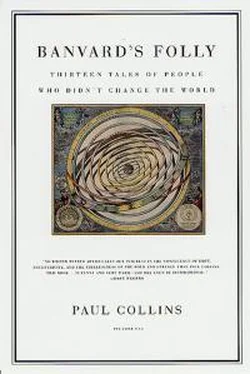Even if they had paid the full fee, the sailors would have got their money's worth that afternoon. As the painted landscape glided by behind him, Banvard described his travels upon the river-a tall tale of pirates, colorful frontier eccentrics, hairbreadth escapes, and wondrous vistas, a tad exaggerated, perhaps, but it still convinced a hallful of sailors who could have punctured his veracity with a single catcall. When he gave his evening performance, crew recommendations to passengers boosted his take to $10--not bad for an evening's work in 1846. With each performance the audience grew, and within a few days he was playing to a packed house.
Flush with money and a successful debut, Banvard returned to his studio and added more sections to the painting, and then he moved it to a larger venue.
The crowds continued to pour in, and nearby towns chartered steamboats to see the show. With the added sections, the show stretched to over two hours in length; the canvas would be cranked faster or slower depending on audience response. Each performance was unique, even for a customer who sat through two in a row. The canvas wasn't rewound at the end of the show, so the performances alternated between upriver and downriver journeys.
After a successful shakedown cruise, Banvard was ready to take his "Three Mile Painting" to the big city. He held his last Louisville show on October 31 and then headed for the epicenter of American intellectual culture: Boston.
Banvard installed his panorama in Boston's Armory Hall in time for the Christmas season. He had honed his delivery to a perfect blend of racy improvisation, reminiscences, and tall tales about infamous frontier brigands.
The crank machinery was now hidden from the audience, and Banvard had commissioned a series of piano waltzes by Thomas Bricher to accompany his narration. With creative lighting and the unfurling American landscape behind him, Banvard had created a seemingly perfect synthesis of media.
Audiences loved it. By Banvard's account, in six months 251,702 Bostonians viewed his extraordinary show; at fifty cents a head, he'd made about $100,000
in clear profit. In just one year, he'd gone from modest frontier sign painter to famous and wealthy man--and probably the country's richest artist. When he published the biographical pamphlet Description of Banvard's Panorama of the
Mississippi River (1847) and a transcription of his show's music, The Mississippi Waltzes, he made more money. But there was an even happier result to his inclusion of piano music--the young pianist he'd hired to perform it, Elizabeth Goodman, soon became his fiancee, and then his wife.
Accolades continued to pour in, culminating in a final Boston performance that saw the governor, the speaker of the house, and state representatives in the audience unanimously passing a resolution to honor Banvard. His success was also the talk of Boston's intellectual elite. John Greenleaf Whittier titled a book after it (The Panorama and Other Poems) in 1856, and Henry Wadsworth Longfellow wrote about the Mississippi in his epic Evangeline after seeing one of Banvard's first Boston performances. Longfellow had never seen the river himself--to him, the painting was real enough to suffice. In fact, Longfellow was to invoke Banvard again in his novel Kavanaugh, using him as the standard by which future American literature was to be judged: "We want a national epic that shall correspond to the size of the country; that shall be to all other epics what Banvard's panorama of the Mississippi is to all other paintings--the largest in the world."
There is little doubt that Banvard's "Three Mile Painting" was the longest ever produced. But it was a misleading appellation. John Hanners --the scholar who almost single-handedly has kept Banvard's memory alive in our time--points out: "Banvard always carefully pointed out that others called it three miles of canvas. ... The area in its original form was 15,840 square feet, not three miles in linear measurement."
But perhaps Banvard was in no hurry to correct the public's inflated perceptions of his painting. His fame was now preceding him, and he moved his show to New York City in 1847 to even bigger crowds and greater enrichment; it was hailed there as "a monument of native talent and American genius." Each night's receipts were carted to the bank in locked strongboxes; rather than count the massive deposits, the banks simply started weighing Banvard's haul.
With acclaim and riches came the less sincere flattery of his fellow artists.
The artist closest upon Banvard's heels was John Rowson Smith, who had painted a supposed "Four Mile Painting." For all Banvard's tendencies toward exaggeration, there is even less reason or evidence to believe that his opportunistic rivals produced panoramas larger than his. Still, it was a worrisome trend. Banvard had been hearing for some time of plans by unscrupulous promoters to copy his painting and to then show the pirated work in Europe as the "genuine Banvard panorama." With the United States success behind him, Banvard closed his New York show and booked a passage to Liverpool.
Banvard spent the summer of 1848 warming up for his London shows with short runs in Liverpool, Manchester, and other smaller cities. In London, the enormous Egyptian Hall was booked for his show. He began by suitably impressing the denizens of Fleet Street papers with a special showing. "It is impossible," the Morning Advertiser marveled, "to convey an adequate idea of this magnificent [exhibition]." The London Observer was equally impressed in its review of November 27, 1848: "This is truly an extraordinary work. We have never seen a work ... so grand in its whole character." Banvard was rapidly achieving a sort of artistic beatification in the press.
The crowds and the money flowed in yet again. But to truly bring in the chattering classes, Banvard needed something that he'd never had in the United States: the imprimatur of royalty. After much finagling and plotting by Banvard, he was summoned to Windsor Castle on April 11, 1849, for a special performance before Queen Victoria and the royal family. Banvard was already a rich man, but royal approval could make the difference between being a mere
artistic showman and an officially respected painter. Banvard gave the performance of his life, delivering his anecdotes in perfect combination with his wife at the piano; at the end, when he gave his final bow to the family assembled at St. George's Hall, Banvard knew that he had made it as an artist.
For the rest of his life, he was to look back upon this as his finest hour.
His panorama show was now a sensation, running for a solid twenty months in London and drawing more than 600,000 spectators. An enlarged and embellished reprint of his autobiographical pamphlet, now titled Banvard, or the Adventures of an Artist (1849), also sold well to Londoners, and his show's waltzes could be heard in many a parlor. He penetrated every level of society; after attending one show, Charles Dickens wrote him in an admiring letter: "I was in the highest degree interested and pleased by your picture." To the other dwellers of this island nation, whose experience of sailing was often that of stormy seas, Banvard offered the spice of frontier danger blended with the honeyed idylls of riverboat life:
Certainly, there can be no comparison between the comfort of the passage from Cincinnati to New Orleans in such a steamboat, and to a voyage at sea. The barren and boundless expanse of waters soon tires upon every eye but a seaman's. And then there are storms, and the necessity of fastening the tables, and of holding onto something, to keep in bed. There is the insupportable nausea of sea sickness, and there is danger. Here you are always near the shore, always see green earth; can always eat, write and study, undisturbed. You can always obtain cream, fowls, vegetables, fruit, fresh meat, and wild game, in their season, from the shore.
Читать дальше











